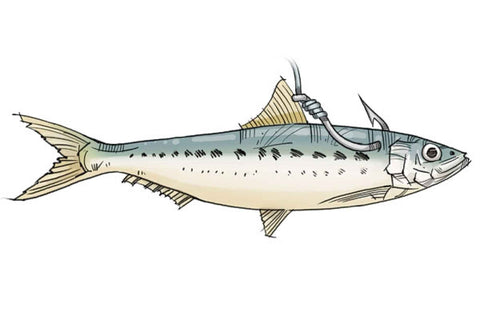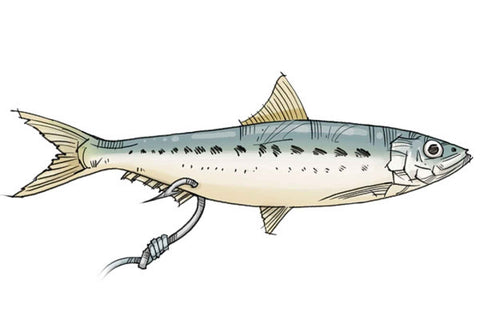Fishing live bait is one of the most productive and easiest ways to catch a variety of different fish in Southern California. Finding out which bait to fish, how to hook it, and how to fish it can be difficult for anglers to understand. I'll explain some of the methods we use to hook live bait and how the different hook placements changes the way the bait swims. The location of the hook guides the bait to do different things.
One of the most popular methods is to nose hook. Going through the nostrils of the nose is great for most fishing conditions and the hook stays in the bait well. The nostrils of the bait are surrounded by bone or cartilage that keeps the hook from pulling through.
Nose Hook

It also allows the bait to swim freely if given light tension by the angler. With a nose hook flylined (just the hook, no weight) the bait will tend to stay in the upper part of the water column. This is generally the best way to hook a bait if the fish are in the upper part of the column and feeding on or near the surface, but the bait tends to do what it wants to do.
Shoulder Hook

A shoulder hooked bait will tend to stay on or just below the surface while throat hooked baits tend to go down in the column. If you need it to go deeper or birds are attacking your bait before you can get bit, use a sliding egg sinker to get down. In order to know what method to employ, you have to know the conditions.
Butt Hook

If you just need it to get out of range of the birds, try an 1/8oz egg sinker. Slide it onto your line without a swivel, tie on the hook, and let it slide right up to the hook. When you pin your bait on and it starts swimming, the weight will slide away from the bait keeping it down, but won't impair the action of the bait too much because now it's a few feet away on your line. The sinker pulls the line down and the bait tends to swim up so it creates a sag in the line.
If you need to get down deeper into the lower upper half of the column, put on a little heavier sinker. I tend to use 3/8oz and sometimes half but normally not more than 1/2oz for a regular sardine. If you're using big mackerel, you may need to put on heavier egg sinkers and long range guys will even use up to 6 or 8 oz egg sinkers on bigger baits for bigger tuna.
When fishing a bait, if you reach into the tank and grab the liveliest bait you can see, pin it on, and it swims horrible, take it off and throw it back. When you put the bait on and it hits the water, it should swim hard and fast. Let it go and don't thumb the spool too hard. You should let it swim as free as you can without getting a backlash. Some baits just don't swim well with a hook in them even though they looked great in the tank. Having a good strong hooked bait is one of the keys to getting bit more often. If it starts out good but then tires out in a few minutes, take it off and put another one on.

Often times I hear about guys saying they get backlashes when letting a strong bait swim. They blame it on the line or the reel but often times it's just the spool tensioner (cast control) needs to be tightened a little. The way it works is as you turn it clockwise, it moves the knob closer to a pin that is attached to the spool. The knob has a little pad inside to help create friction on the spool pin. The more you tighten, the more tension on the spool and the slower it spins. Put just enough tension on the spool to slow it a little, this will reduce backlashes while fishing live bait, throwing lures, or free spooling a dropper loop to the bottom.
Knowing how to fish a live bait can make the difference between getting bit and not. When you're on the water try hooking your bait different ways to see how it makes a difference. Learning what the bait does with each method and understanding when to use those methods is key to being a better fisherman.
Being a better fisherman and catching more and bigger fish is about understanding the little details. It's the little things that matter the most and translate into the biggest rewards.

